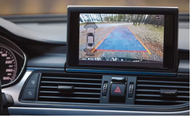Understanding Rear Vision Safety
Posted by Bill Castleberry
10th Jul 2024
According to the latest available government statistics, there are about 210 deaths and 15,000 injuries every year from backover accidents involving light vehicles. Tragically, 31 percent of those fatalities involve children under the age of five. These numbers sadly illustrate that what is behind your vehicle is just as important as what is seen through the windshield. Each day auto glass replacement professionals are on the front lines of delivering a safe and legally compliant auto glass installation. However, “rear vision safety” and the federal legal guidelines surrounding side and rearview mirrors are not as fully understood.
FMVSS 111 and K.D. Safety Act
The National Highway Transportation Safety Administration details automotive rear vision safety guidelines through Federal Motor Vehicle Safety Standard 111. Code of Federal Regulations Title 49 Section 577.111 addresses rear visibility specifically for all vehicles that are under Section 103 of the NTMV Safety Act of 1966. Prior to May 2018, this regulation required the inside-mounted rearview mirror to have a 20-degree field of view and the driver’s side external mirror to see a zone of 7’10” from 35’ behind the driver’s eyes. The K.D. Safety Act of 2007 was signed into federal law and was named after a two-year-old, Cameron Gulbransen, who tragically was run over by his father’s SUV when the rearview mirrors failed to show the boy immediately behind the vehicle. Cameron’s father Greg wrote, “This story has happened to too many other families and will continue to happen at an alarming rate if we as drivers are not informed about the real danger of driving vehicles with larger blind spots.” This federal rule was intended to make consumer-grade vehicles safe near children who are too small to be seen by drivers. This Transportation Act, “…expands the required FMVSS 111 field of view to enable the driver of a motor vehicle to detect areas behind the vehicle to reduce death and injury resulting from backing incidents, particularly incidents involving small children and disabled persons. Such a standard may be met by the provision of additional mirrors, sensors, cameras or other technology to expand the driver’s field of view.”
Backup Camera Law– The “New” FMVSS 111
With almost all FMVSS regulations, the law is dynamic and evolves over time. As of May 1, 2018, all new vehicles manufactured on or after that date with a gross weight rating of 10,000 pounds or less are required to be equipped to have a clear field of view for the 10-by-20-foot zone immediately behind the vehicle. To comply with this revision, backup cameras are now required in all vehicles built after the aforementioned revision date.
Cameras and Mirrors Work Together
A January 25, 2021 article in MarketWatch forecasts a 6% compound annual growth rate (2017-2023) for the automotive rear view mirror market. This growth is driven by technology and innovations by side- and rear-view mirror manufacturers. All of these specialty mirrored products further enhance rear vision safety.






